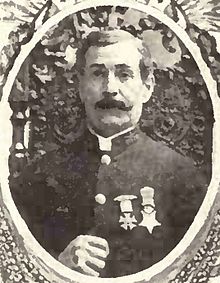|
Marcus Robbins
Marcus Morton Robbins (July 25, 1851 – June 21, 1924) served in the United States Army during the American Indian Wars. He received the Medal of Honor. Robbins was a resident of Elba, Wisconsin. He died at his daughter's home in Pittsfield, Massachusetts on June 21, 1924, and was buried in Pittsfield Cemetery.[1][2] Army serviceRobbins served as a private in the Sixth U.S. Cavalry, fighting in the American Indian Wars On April 23, 1875, Robbins and five other soldiers snuck up behind a band of Cheyenne warriors and attacked them from the rear at the Battle at Sappa Creek in Kansas. He received a Medal of Honor for these actions on November 16, 1876.[3] Several other members of his company also received medals for their role in the battle. Richard Longstreth Tea, Frederick Platten, James Lowthers, Simpson Hornaday, and Peter W. Gardiner made up the rest of the expedition around the Cheyenne lines, and all received the Medal of Honor. Michael Dawson and James F. Ayers also were a part of the battle, and also were awarded the Medal of Honor.[4] The engagement was part of the Red River War. Twentieth-century commentators have questioned the role of the Sixth Cavalry at Sappa Creek, with some calling it a "massacre."[5] Medal of HonorHis award citation reads:
The medal itself was out of possession of Robbins' family for many years, until it was returned to them in 2009.[7] See alsoReferences
External links
|
||||||||||||||||||||||
